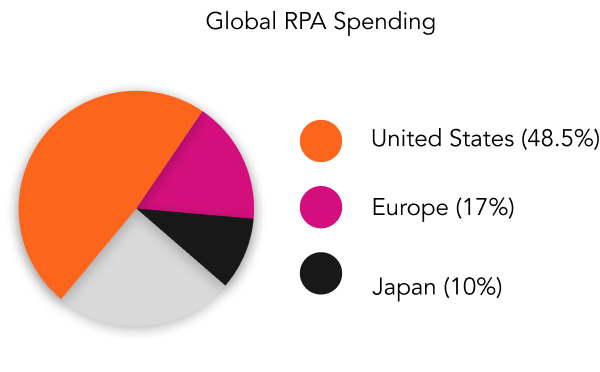From exciting, new applications to electrifying tech innovations, the twin fields of artificial intelligence and automation are evolving every day. If you missed the latest developments making the news, we have you covered. Here’s a quick recap of the top three AI and automation stories worth knowing.
Gartner: Global RPA Software Spending to Reach $2.9 Billion in 2022
According to Gartner, worldwide spending on robotic process automation (RPA) software is poised to reach $2.9 billion this year, an increase of 19.5% from 2021. Analysts for the technological research and consulting firm predict this trend to continue into 2023, with a growth forecast of 17.5%. “Organizations are leveraging RPA to accelerate business process automation initiatives and digital transformation plans, linking their legacy nightmares to their digital dreams to improve operational efficiency,” says Cathy Tornbohm, Distinguished VP Analyst at Gartner.

Globally, the United States accounts for nearly half of all RPA spending (48.5%), followed by Europe (17%) and Japan (10%). This year’s continued double-digit growth is seen as a major step toward hyper-automation, with companies investing heavily in foundational automation software with an eye toward future capabilities. “RPA vendors are pushing beyond a traditional single technology-focused offering to a more advanced suite of tools that encompasses low-code application platforms, process mining, task mining, decision modeling, iPaaS, computer vision and IDP capabilities on top of their existing RPA offering,” explains Gartner Senior Market Research Specialist, Varsha Mehta. “This allows them to offer, or rather makes them poised to offer, an all-encompassing hyper-automation-enabling technology platform.”
Artificial Intelligence Model Can Help Detect Signs of Parkinson’s
Researchers at MIT recently developed an artificial intelligence model that can detect signs of Parkinson’s disease based on a subject’s breathing patterns. The model—a series of algorithms that mimic a human neural network—analyzes a person’s nocturnal breathing for specific Parkinson’s indicators. It can then determine the severity of the disease and track its progression over time.
“A relationship between Parkinson’s and breathing was noted as early as 1817, in the work of Dr. James Parkinson,” explains MIT Professor Dina Katabi. “This motivated us to consider the potential of detecting the disease from one’s breathing without looking at movements. Some medical studies have shown that respiratory symptoms manifest years before motor symptoms, meaning that breathing attributes could be promising for risk assessment prior to Parkinson’s diagnosis.”
Unlike earlier detection methods, which relied on neuroimaging and cerebrospinal fluid analysis, the new AI-based model is non-invasive and significantly less costly.
This is welcomed news to the medical community and those afflicted with the disease. Currently the fastest-growing neurological disease in the world, Parkinson’s affects one million people in the United States alone—second only to Alzheimer’s disease in the number of cases.
MIT Study: New Opportunities for Emotion AI in Mental Health
It’s been a busy month for AI researchers at the Massachusetts Institute of Technology (MIT). At the same time one team explored how AI could be used to detect Parkinson’s disease, another team revealed new opportunities for artificial emotional intelligence in the field of mental health. The new study by the Affective Computing Research Group at the MIT Media Lab provides empirical evidence that computational empathy generated by AI and machine learning can counteract anger in human problem solving.
The study looked at how players of the popular word game, Wordle, performed when exposed to conditions that elicited anger and empathy. It found that when emotion AI introduced computational empathy, it reduced the negative effects of anger on creative problem solving. According to Rosalind W. Picard, Sc.D., FIEEE, who participated in the study, the technology opens up new avenues for addressing mental illnesses, such as depression and anxiety.
“With respect to mental health and AI, I think there are a lot of opportunities,” said Picard. “We have a lot to learn from the psychological community, we are not trying to replace them. I think building an AI that replaces people in general is a really bad idea. What we’re looking at is how to build the kind of AI that augments and expands what people can do.”
